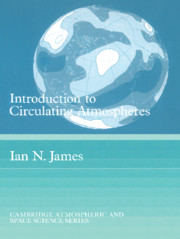Book contents
- Frontmatter
- Contents
- Preface
- Notation
- l The governing physical laws
- 2 Observing and modelling global circulations
- 3 The atmospheric heat engine
- 4 The zonal mean meridional circulation
- 5 Transient disturbances in the midlatitudes
- 6 Wave propagation and steady eddies
- 7 Three-dimensional aspects of the global circulation
- 8 Low frequency variability of the circulation
- 9 The stratosphere
- 10 Planetary atmospheres and other fluid systems
- Appendix: Solutions to Problems
- Bibliography
- References
- Index
4 - The zonal mean meridional circulation
Published online by Cambridge University Press: 14 January 2010
- Frontmatter
- Contents
- Preface
- Notation
- l The governing physical laws
- 2 Observing and modelling global circulations
- 3 The atmospheric heat engine
- 4 The zonal mean meridional circulation
- 5 Transient disturbances in the midlatitudes
- 6 Wave propagation and steady eddies
- 7 Three-dimensional aspects of the global circulation
- 8 Low frequency variability of the circulation
- 9 The stratosphere
- 10 Planetary atmospheres and other fluid systems
- Appendix: Solutions to Problems
- Bibliography
- References
- Index
Summary
Observational basis
The large scale structure of the atmospheric flow varies most rapidly in the vertical direction, and least rapidly in the zonal direction. Zonal averaging therefore makes the important vertical and meridional variations plain, and has been employed for many years as a compact way of studying the global circulation. Indeed, for many writers, the global circulation is simply the pattern of flow projected on to the meridional plane. In this book, we will take a broader view by attempting to summarize our current understanding of the full, evolving three-dimensional pattern of winds and temperature in the atmosphere. But the traditional zonal mean view is a useful starting point which we will explore in this chapter.
The zonal mean wind and vectors of the mean meridional wind are illustrated in Fig. 4.1, based on ECMWF analyses. Rising motion is seen in the tropics, with the maximum vertical velocity in the summer hemisphere. Strongest descent is at latitudes of around 25 – 30° in the winter hemisphere, with flow towards the equator near the surface and away from the tropics in the upper troposphere, as is required by continuity. Such an axisymmetric circulation is the most obvious response of the atmospheric flow to the net heating excess in the tropics and the deficit at high latitudes discussed in the preceding chapter.
- Type
- Chapter
- Information
- Introduction to Circulating Atmospheres , pp. 80 - 111Publisher: Cambridge University PressPrint publication year: 1994



